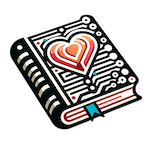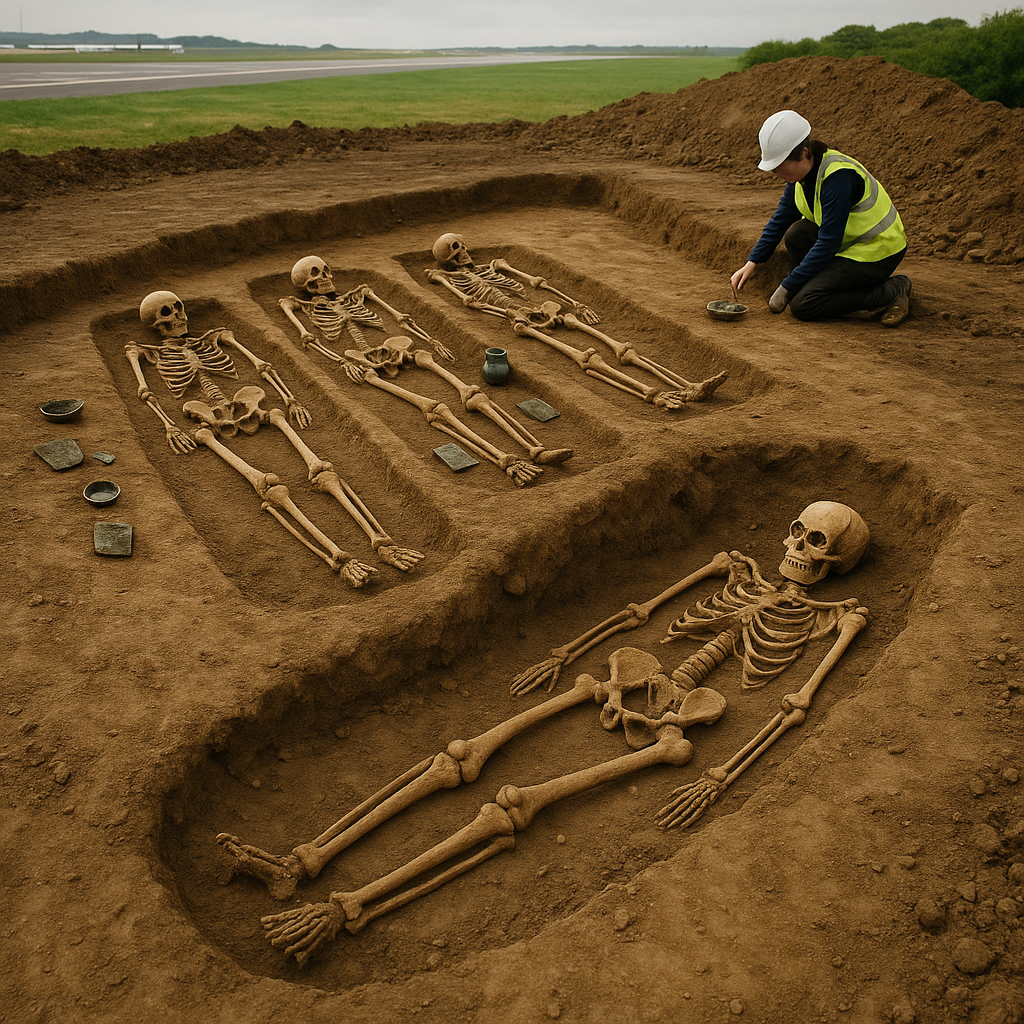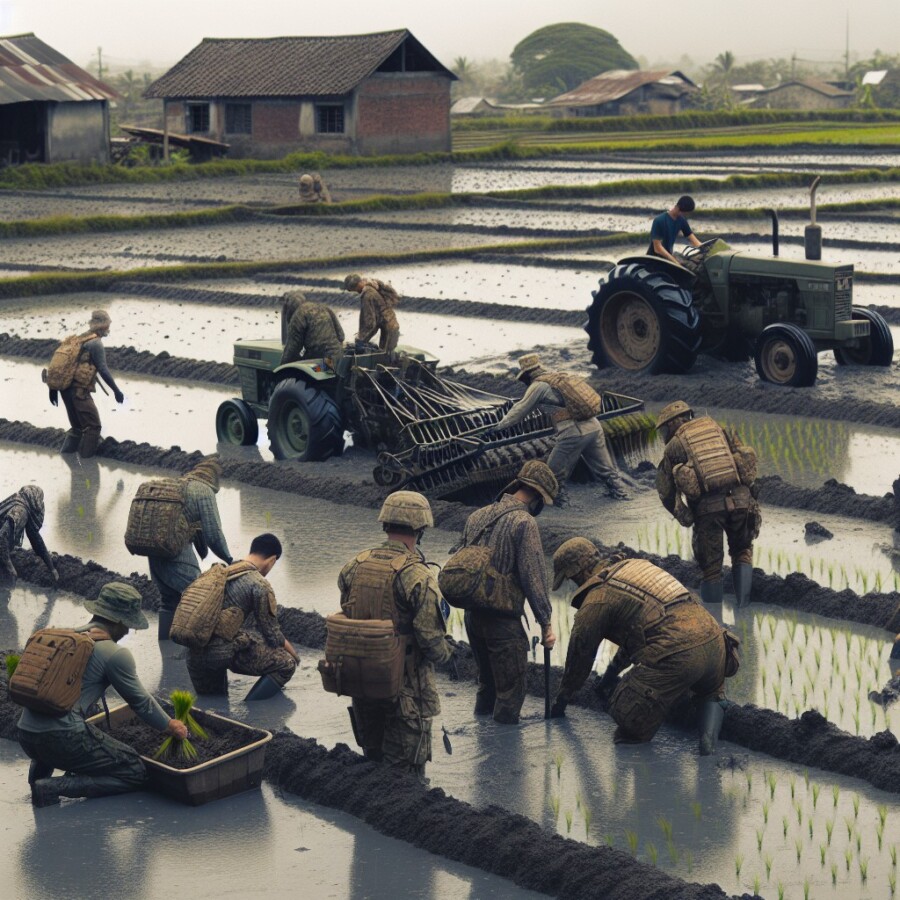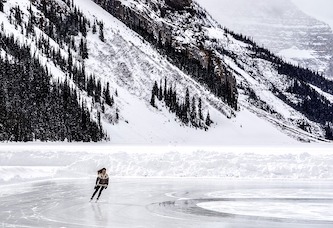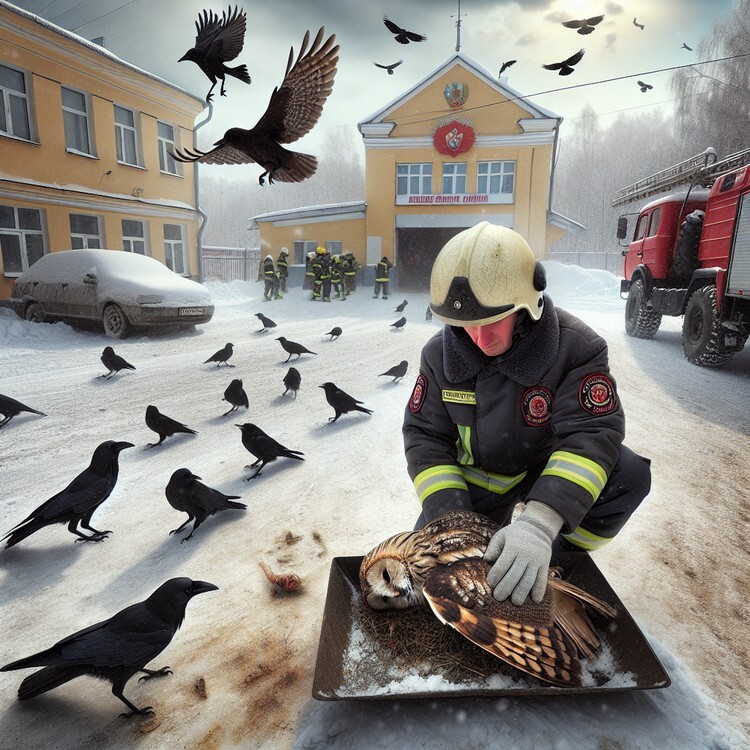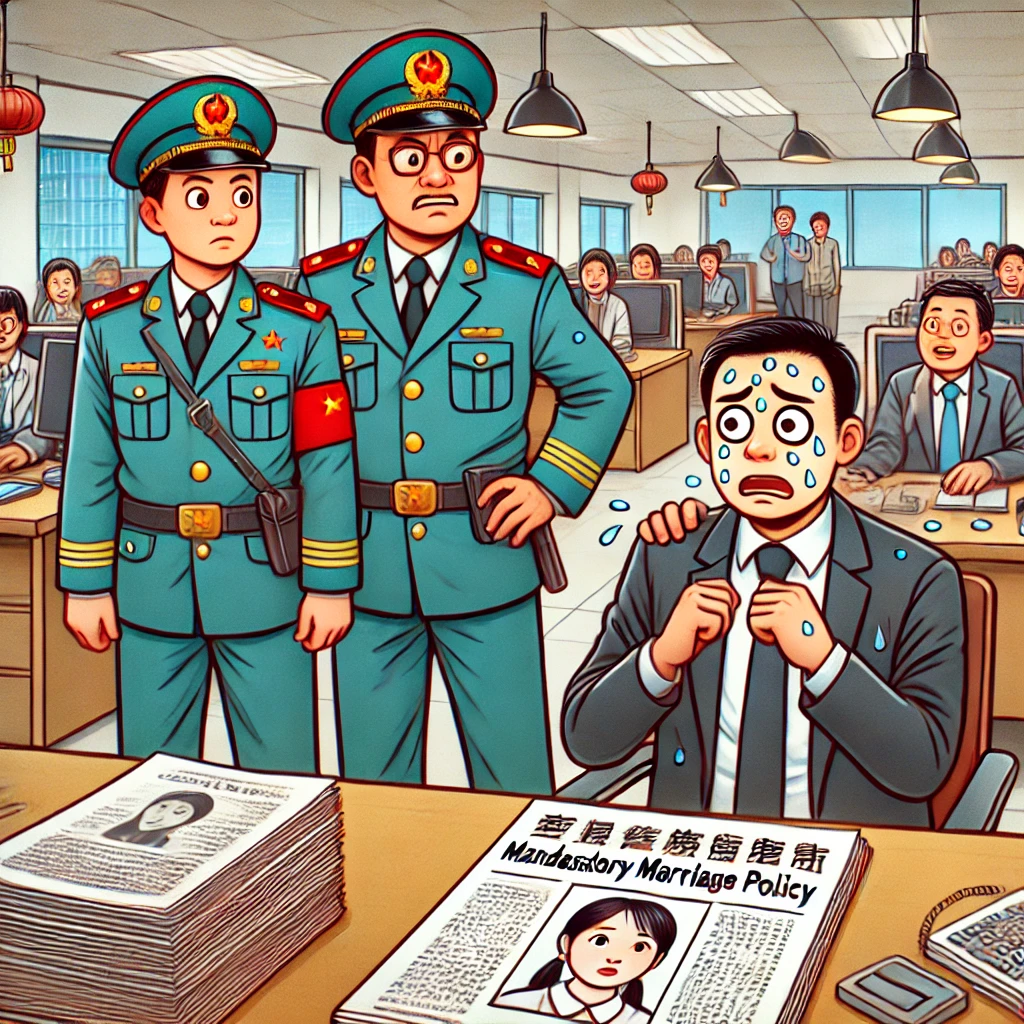A medieval cemetery found near Cardiff Airport is raising a lot of interesting questions for archaeologists. This site, which was first announced last year, dates back to the 6th or 7th century and has revealed 41 skeletons buried in strange positions along with some surprising artifacts. Most of the skeletons belong to women, and their bones show signs that they did a lot of hard work. At the same time, these women also seem to have been wealthy, making it harder to understand what life was like for this community.
One skeleton is particularly unusual because it was found in a ditch, unlike the others that were buried carefully. Andy Seaman, the project leader from Cardiff University, mentioned that each new finding makes it harder to piece together the story of this cemetery. So far, they have found 39 adult skeletons, mostly female, and researchers are still trying to figure out what this gender pattern means for the people buried there.
The excavation has also revealed the remains of two children, which is surprising because many infants died during medieval times. The way these children were buried is different from the adults, suggesting there might have been a gap in time between the two burials. Archaeologist Dr. Marion Shiner pointed out that the soil used for the children’s graves has unique features, adding to the mystery of the site.
The artifacts discovered, like pieces of pottery and fine glass, show that this community was likely quite special. The glass, which probably came from far away places like the Levant and was made in southern France, suggests that the people buried here had some status. Each burial was done with care, with bodies placed in different positions, all facing east to west. The treatment of the woman found in the ditch raises questions about her social status, leading researchers to think she might have been an outcast or a criminal. As the team continues their work, they hope to learn more about the diets and backgrounds of the people buried in this cemetery, revealing more about a time in history that often gets overlooked.
Original news source: Mystery of medieval cemetery near airport runway deepens (BBC)
🎧 Listen:
Slow
Normal
Fast
📖 Vocabulary:
| 1 | archaeologists | People who study ancient cultures by examining their remains |
| 2 | artifacts | Objects made by humans, typically of historical interest |
| 3 | skeletons | The bones of a human or animal |
| 4 | excavation | The process of digging up and studying ancient sites |
| 5 | medieval | Relating to the Middle Ages, a period in European history |
| 6 | cemetery | A place where dead people are buried |
| 7 | ditch | A narrow channel dug in the ground |
| 8 | unique | Being the only one of its kind; special |
| 9 | pottery | Objects made from clay and hardened by heat |
| 10 | Levant | A historical region in the Eastern Mediterranean |
| 11 | status | A person’s social or professional position |
| 12 | outcast | Someone who is rejected or excluded by society |
| 13 | criminal | A person who has committed a crime |
| 14 | backgrounds | The details of a person’s past, including their family and education |
| 15 | overlooked | Not given enough attention or consideration |
Group or Classroom Activities
Warm-up Activities:
– CHARADES
Instructions: Students will take turns acting out key terms or concepts from the article (e.g., “archaeologist,” “skeleton,” “burial”) without speaking, while their classmates guess the word. This activity will help reinforce vocabulary and encourage nonverbal communication skills.
– HEADLINE CREATION
Instructions: In small groups, students will create catchy headlines for the article. They should focus on summarizing the main points and intrigue potential readers. Afterward, each group will share their headlines with the class, and a discussion will follow about which headlines are most effective and why.
– OPINION POLL
Instructions: Students will discuss their views on the importance of archaeological findings like those mentioned in the article. They will then conduct a quick poll in pairs, asking each other questions like “Do you think it’s important to study medieval cemeteries?” and “What do you think we can learn from them?” Groups will then share their findings with the class.
– MIND MAP
Instructions: As a class, create a mind map on the board that outlines the key points of the article. Students will contribute ideas and concepts related to the cemetery findings, the significance of the artifacts, and the gender patterns observed. This activity promotes collaborative thinking and helps students visualize connections between ideas.
– PASS THE STORY
Instructions: In a circle, students will take turns adding a sentence to create a story based on the article. They can incorporate elements from the findings, the artifacts, or the community’s life. This encourages creativity and allows students to practice their speaking and storytelling skills while reinforcing the content from the article.
🤔 Comprehension Questions:
1. What time period does the medieval cemetery near Cardiff Airport date back to?
2. How many skeletons have been found at the site, and what is unusual about their burial positions?
3. Why is the discovery of mostly female skeletons significant for understanding the community?
4. What does the burial of the two children suggest about the time between their deaths and the deaths of the adults?
5. What types of artifacts were found at the cemetery, and what do they indicate about the community’s status?
6. How does the burial position of the woman found in the ditch differ from the others, and what questions does this raise?
7. What unique features were found in the soil of the children’s graves, and why is this important?
8. What are the researchers hoping to learn more about as they continue their excavation of the cemetery?
Go to answers ⇩
🎧✍️ Listen and Fill in the Gaps:
A medieval cemetery found near Cardiff (1)______ is (2)______ a lot of interesting questions for archaeologists. This site, which was first announced last year, dates back to the 6th or 7th century and has revealed 41 skeletons (3)______ in strange positions along with some surprising (4)______. Most of the skeletons belong to women, and their bones show signs that they did a lot of hard work. At the same time, these women also seem to have been wealthy, making it harder to understand what life was like for this community.
One skeleton is particularly unusual because it was found in a ditch, unlike the others that were buried carefully. Andy Seaman, the project leader from (5)______ University, mentioned that each new finding makes it harder to piece together the story of this cemetery. So far, they have found 39 adult skeletons, mostly female, and (6)______ are still trying to figure out what this gender pattern means for the people buried there.
The (7)______ has also revealed the remains of two (8)______, which is surprising because many infants died during medieval times. The way these children were buried is (9)______ from the adults, suggesting there might have been a gap in time between the two burials. Archaeologist Dr. Marion Shiner pointed out that the soil used for the children’s graves has unique (10)______, adding to the mystery of the site.
The artifacts discovered, like pieces of pottery and fine glass, show that this (11)______ was likely quite special. The glass, which probably came from far away places like the (12)______ and was made in southern France, suggests that the people buried here had some status. Each (13)______ was done with care, with bodies placed in different positions, all facing east to west. The treatment of the woman found in the ditch (14)______ questions about her social status, leading researchers to (15)______ she might have been an outcast or a criminal. As the team (16)______ their work, they hope to learn more about the diets and backgrounds of the people buried in this cemetery, revealing more about a time in history that often gets overlooked.
Go to answers ⇩
💬 Discussion Questions:
Students can ask a partner these questions, or discuss them as a group.
1. What is your opinion on the importance of archaeology in understanding history?
2. How would you feel if you discovered an ancient artifact in your backyard?
3. Do you think it’s important to study the lives of women in history? Why or why not?
4. What is a burial practice in your culture that you find interesting?
5. How do you think people in the past viewed social status compared to today?
6. Do you like learning about different cultures and their histories? Why or why not?
7. How would you feel if you were part of a team uncovering a historical site?
8. Do you think that the way people are buried says a lot about their lives? Why?
9. What is a mystery from history that you would like to solve?
10. How do you think discoveries like this cemetery change our understanding of the past?
11. Do you think it’s fair to label someone as an outcast based on their burial? Why or why not?
12. What is your opinion on how children were treated in medieval times?
13. How would you feel if you were buried in a way that was different from everyone else?
14. Do you think that wealthy people in the past had very different lives than poorer people? Why?
15. What is a question you would ask an archaeologist if you had the chance?
Individual Activities
📖💭 Vocabulary Meanings:
Match each word to its meaning.
Words:
1. archaeologists
2. artifacts
3. skeletons
4. excavation
5. medieval
6. cemetery
7. ditch
8. unique
9. pottery
10. Levant
11. status
12. outcast
13. criminal
14. backgrounds
15. overlooked
Meanings:
(A) The bones of a human or animal
(B) People who study ancient cultures by examining their remains
(C) Objects made by humans, typically of historical interest
(D) The process of digging up and studying ancient sites
(E) A place where dead people are buried
(F) A narrow channel dug in the ground
(G) Being the only one of its kind; special
(H) A person who has committed a crime
(I) Someone who is rejected or excluded by society
(J) Relating to the Middle Ages, a period in European history
(K) A person’s social or professional position
(L) Not given enough attention or consideration
(M) A historical region in the Eastern Mediterranean
(N) Objects made from clay and hardened by heat
(O) The details of a person’s past, including their family and education
Go to answers ⇩
🔡 Multiple Choice Questions:
1. What time period does the medieval cemetery near Cardiff Airport date back to?
(a) 8th or 9th century
(b) 4th or 5th century
(c) 10th or 11th century
(d) 6th or 7th century
2. How many skeletons have been found at the site so far?
(a) 39
(b) 37
(c) 41
(d) 43
3. What is unusual about one of the skeletons found at the site?
(a) It belonged to a child
(b) It was found in a ditch
(c) It was buried with jewelry
(d) It was found standing up
4. What does the presence of artifacts like fine glass suggest about the community?
(a) They were likely quite special
(b) They were very poor
(c) They had no trade connections
(d) They were nomadic
5. How were the bodies in the cemetery typically positioned?
(a) Facing east to west
(b) Facing north to south
(c) Standing upright
(d) In random positions
6. What does the treatment of the woman found in the ditch suggest about her?
(a) She was a queen
(b) She was a child
(c) She was a healer
(d) She might have been an outcast or a criminal
7. What unique feature did the soil used for the children’s graves have?
(a) It was very dry
(b) It had unique features
(c) It was very rocky
(d) It was mixed with sand
8. What are researchers hoping to learn more about as they continue their work at the cemetery?
(a) The weather conditions of the time
(b) The types of animals that lived nearby
(c) The diets and backgrounds of the people buried there
(d) The architecture of the burial sites
Go to answers ⇩
🕵️ True or False Questions:
1. One skeleton was found in a grave, which is similar to the others.
2. The cemetery dates back to the 8th or 9th century.
3. Archaeologists have found 41 skeletons buried in typical positions.
4. The excavation revealed the remains of two children, which is rare for that time.
5. Most of the skeletons belong to women who showed signs of hard work.
6. A modern cemetery was discovered near Cardiff Airport.
7. The burial practices suggest that the women were likely wealthy.
8. Artifacts like pottery and fine glass indicate that the community had some status.
Go to answers ⇩
📝 Write a Summary:
Write a summary of this news article in two sentences.
Check your writing now with the best free AI for English writing!
Writing Questions:
Answer the following questions. Write as much as you can for each answer.
Check your answers with our free English writing assistant!
1. What unusual finding was discovered about one of the skeletons in the cemetery near Cardiff Airport?
2. Why is it surprising to find the remains of two children in this medieval cemetery?
3. What do the artifacts, like pottery and glass, tell us about the community that lived in this area?
4. How does the burial position of the skeletons suggest something about their social status?
5. What do researchers hope to learn more about as they continue their work at the cemetery?
✅ Answers
🤔✅ Comprehension Question Answers:
1. What time period does the medieval cemetery near Cardiff Airport date back to?
The cemetery dates back to the 6th or 7th century.
2. How many skeletons have been found at the site, and what is unusual about their burial positions?
41 skeletons have been found, and many of them are buried in strange positions, unlike typical burials.
3. Why is the discovery of mostly female skeletons significant for understanding the community?
The discovery of mostly female skeletons raises questions about the role of women in the community, especially since they show signs of hard work but also seem to have been wealthy.
4. What does the burial of the two children suggest about the time between their deaths and the deaths of the adults?
The different burial methods for the two children suggest there might have been a gap in time between their deaths and the deaths of the adults.
5. What types of artifacts were found at the cemetery, and what do they indicate about the community’s status?
Artifacts like pottery and fine glass were found, indicating that the community was likely special and that the people buried there had some status.
6. How does the burial position of the woman found in the ditch differ from the others, and what questions does this raise?
The woman found in the ditch was not buried carefully like the others, raising questions about her social status and whether she might have been an outcast or a criminal.
7. What unique features were found in the soil of the children’s graves, and why is this important?
The soil in the children’s graves has unique features, which adds to the mystery of the site and may help researchers understand more about the burials.
8. What are the researchers hoping to learn more about as they continue their excavation of the cemetery?
Researchers hope to learn more about the diets and backgrounds of the people buried in the cemetery to reveal more about that time in history.
Go back to questions ⇧
🎧✍️✅ Listen and Fill in the Gaps Answers:
(1) Airport
(2) raising
(3) buried
(4) artifacts
(5) Cardiff
(6) researchers
(7) excavation
(8) children
(9) different
(10) features
(11) community
(12) Levant
(13) burial
(14) raises
(15) think
(16) continues
Go back to questions ⇧
📖💭✅ Vocabulary Meanings Answers:
1. archaeologists
Answer: (B) People who study ancient cultures by examining their remains
2. artifacts
Answer: (C) Objects made by humans, typically of historical interest
3. skeletons
Answer: (A) The bones of a human or animal
4. excavation
Answer: (D) The process of digging up and studying ancient sites
5. medieval
Answer: (J) Relating to the Middle Ages, a period in European history
6. cemetery
Answer: (E) A place where dead people are buried
7. ditch
Answer: (F) A narrow channel dug in the ground
8. unique
Answer: (G) Being the only one of its kind; special
9. pottery
Answer: (N) Objects made from clay and hardened by heat
10. Levant
Answer: (M) A historical region in the Eastern Mediterranean
11. status
Answer: (K) A person’s social or professional position
12. outcast
Answer: (I) Someone who is rejected or excluded by society
13. criminal
Answer: (H) A person who has committed a crime
14. backgrounds
Answer: (O) The details of a person’s past, including their family and education
15. overlooked
Answer: (L) Not given enough attention or consideration
Go back to questions ⇧
🔡✅ Multiple Choice Answers:
1. What time period does the medieval cemetery near Cardiff Airport date back to?
Answer: (d) 6th or 7th century
2. How many skeletons have been found at the site so far?
Answer: (c) 41
3. What is unusual about one of the skeletons found at the site?
Answer: (b) It was found in a ditch
4. What does the presence of artifacts like fine glass suggest about the community?
Answer: (a) They were likely quite special
5. How were the bodies in the cemetery typically positioned?
Answer: (a) Facing east to west
6. What does the treatment of the woman found in the ditch suggest about her?
Answer: (d) She might have been an outcast or a criminal
7. What unique feature did the soil used for the children’s graves have?
Answer: (b) It had unique features
8. What are researchers hoping to learn more about as they continue their work at the cemetery?
Answer: (c) The diets and backgrounds of the people buried there
Go back to questions ⇧
🕵️✅ True or False Answers:
1. One skeleton was found in a grave, which is similar to the others. (Answer: False)
2. The cemetery dates back to the 8th or 9th century. (Answer: False)
3. Archaeologists have found 41 skeletons buried in typical positions. (Answer: False)
4. The excavation revealed the remains of two children, which is rare for that time. (Answer: True)
5. Most of the skeletons belong to women who showed signs of hard work. (Answer: True)
6. A modern cemetery was discovered near Cardiff Airport. (Answer: False)
7. The burial practices suggest that the women were likely wealthy. (Answer: True)
8. Artifacts like pottery and fine glass indicate that the community had some status. (Answer: True)
Go back to questions ⇧

